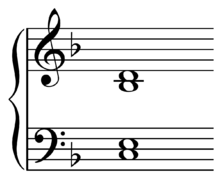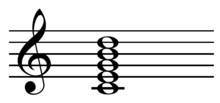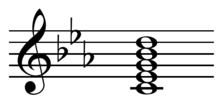- Ninth
-
In music, a ninth is a compound interval consisting of an octave plus a second.
Like the second, the interval of a ninth is classified as a dissonance in common practice tonality. Since a ninth is a larger than a second, its sonority level is considered less dense.[1]
Contents
Major ninth
A major ninth is a compound musical interval spanning 14 semitones, or an octave plus 2 semitones. If transposed into a single octave, it becomes a major second or minor seventh. The major ninth is somewhat dissonant in sound.
Transposition
Some common transposing instruments sound a major ninth lower than written. These include the tenor saxophone, the bass clarinet, the baritone/euphonium when written in treble clef, and the trombone when written in treble clef (British brass band music).
When baritone/euphonium or trombone parts are written in bass clef or tenor clef they sound based.
Minor ninth
A minor ninth (m9 or -9) is a compound musical interval spanning 13 semitones, or 1 semitone above an octave (thus it is enharmonically equivalent to an augmented octave). It is a type of extended minor seventh. If transposed into a single octave, it becomes a minor second or major seventh. The minor ninth is rather dissonant in sound,[citation needed] and in European classical music, often appears as a suspension. Béla Bartók wrote a study in minor 9ths for piano. The fourth movement (an intermezzo) of Robert Schumann's Faschingsschwank aus Wien, is a constructed to feature prominent notes of the melody a minor ninth above the accompaniment. Alexander Scriabin's sonata no. 9, 'black mass' is based around the interval of a minor ninth, creating an uncomfortable and harsh sound.
Augmented ninth
An augmented ninth is a compound musical interval spanning 15 semitones, or 3 semitones above an octave. Enharmonically equivalent to a compound minor third, if transposed into a single octave, it becomes a minor third or major sixth. It is a consonant interval.
Ninth chords
Three types of ninth chords may be distinguished: dominant (9), major (M9), and minor (m9).[2][3] They may easily be remembered as the chord quality of the seventh does not change with the addition of the second scale degree,[2] which is a major second in both major and minor, thus:
0 4 7 t + 2 = dominant seventh + ninth = dominant ninth chord 0 4 7 e + 2 = major seventh + ninth = major ninth chord 0 3 7 t + 2 = minor seventh + ninth = minor ninth chord
The dominant ninth (V9) is a dominant seventh plus a major or minor ninth.[4]
See also
Sources
- ^ Westergaard, Peter (1975). An Introduction to Tonal Theory, p.74. W.W. Norton. ISBN 9780393093421.
- ^ a b Bruce Buckingham, Eric Paschal (2001). Rhythm Guitar: The Complete Guide, p.58. ISBN 9780793581849.
- ^ Michael Miller (2004). Complete Idiot's Guide to Solos and Improvisation, p.51. ISBN 9781592572106.
- ^ Helen S. Leavitt (1916). Practical Lesson Plans in Harmony, p.32. Ginn and Company. "In major keys the dominant ninth is usually major, though occasionally it is chromatically altered to a minor. In minor keys a similar chromatic change from minor to major takes places."
Intervals (list) Numbers in brackets are the number of semitones in the interval.
Fractional semitones are approximate.Twelve-semitone
(Western)PerfectMajorMinorAugmentedDiminishedCompoundOther systems SupermajorNeutralSubminor7-limitchromatic semitone (⅔) · diatonic semitone (1⅙) · whole tone (2⅓) · subminor third (2⅔) · supermajor third (4⅓) · harmonic (subminor) seventh (9⅔)Other intervals GroupsPythagorean comma · Pythagorean apotome · Pythagorean limma · Diesis · Septimal diesis · Septimal comma · Syntonic comma · Schisma · Diaschisma · Major limma · Ragisma · Breedsma · Kleisma · Septimal kleisma · Septimal semicomma · Orwell comma · Semicomma · Septimal sixth-tone · Septimal quarter tone · Septimal third-tone
MeasurementOthersCategories:- Intervals
Wikimedia Foundation. 2010.







